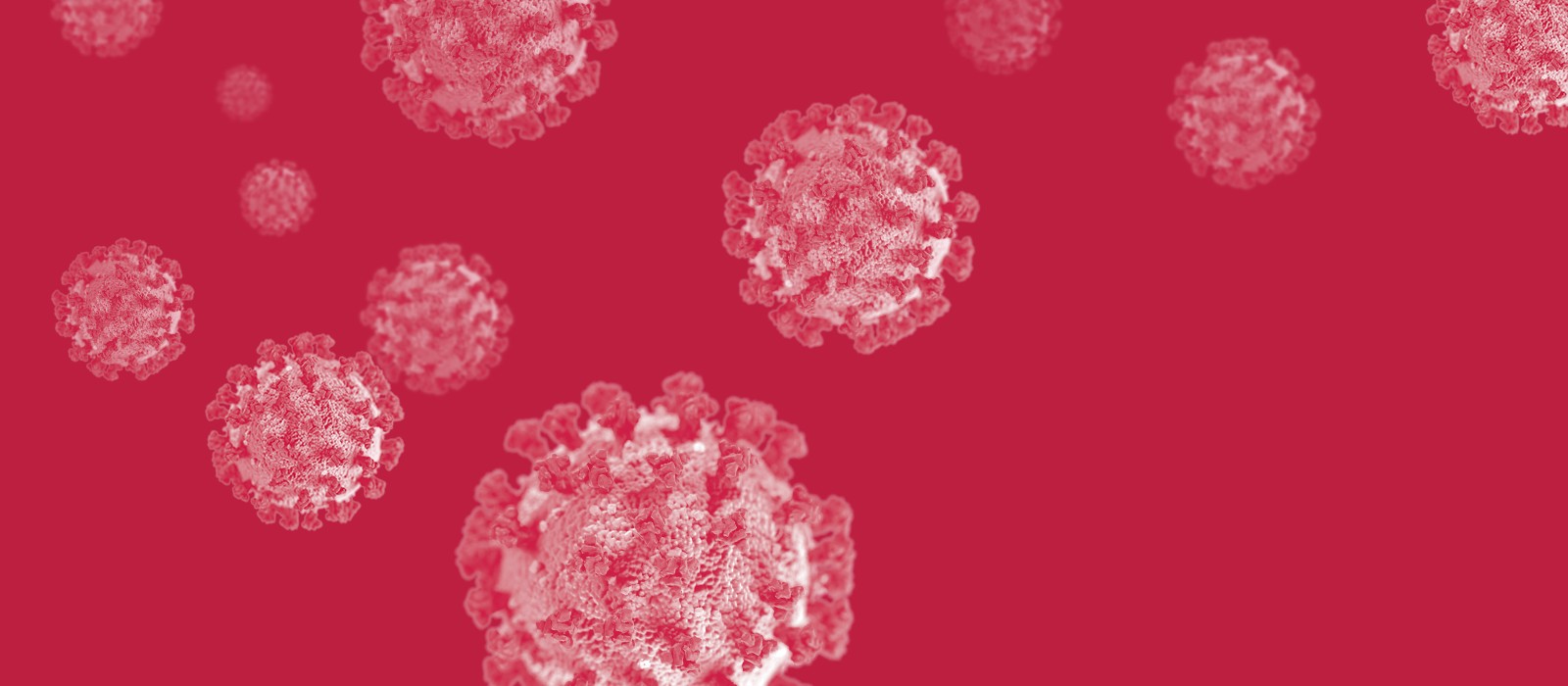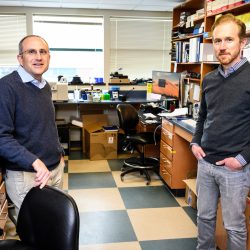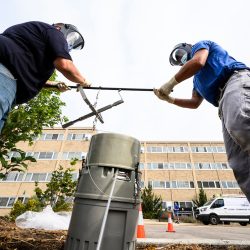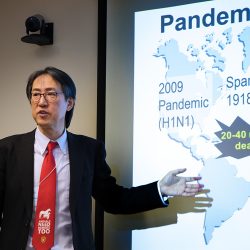
Badgers vs. the Pandemic
Meet UW heroes in the fight against COVID-19.
Louis Pasteur pioneered the rabies vaccine, and Jonas Salk the polio vaccine. By contrast, conquering coronavirus has been a team effort. UW–Madison faculty, staff, and alumni are playing a part, and not just in the laboratory. Badgers have joined the fight across a range of professions, whether treating patients on the front lines or delivering food to grocery stores. Here are eight heroes who’ve stepped up during the pandemic, determined to put the Wisconsin Idea into action. Hats off to them and countless others who will — with courage and creativity — help us through this crisis.
The Doctor
Jesse Charles ’08, MD’14
 “The patients came in like all the others: feverish, coughing, and short of breath — each one of them afraid, each one of them alone,” says Jesse Charles. “I evaluated them, made sure they had water and blankets — anything that could provide them some measure of comfort. Sleep, that most essential of medicines, was completely inaccessible.”
“The patients came in like all the others: feverish, coughing, and short of breath — each one of them afraid, each one of them alone,” says Jesse Charles. “I evaluated them, made sure they had water and blankets — anything that could provide them some measure of comfort. Sleep, that most essential of medicines, was completely inaccessible.”
Jesse has seen the worst effects of the COVID-19 pandemic firsthand. A physician in tiny Winthrop, Washington, he left home in early April and flew to New York, where the pandemic’s effects were worst. When New York governor Andrew Cuomo issued a public call for help, Jesse volunteered to serve at one of the state’s hard-hit medical facilities.
When he arrived, the Brooklyn Health Center, where he was assigned, had already grieved the death of five staff members caused by the virus. In the three weeks that he was there, Jesse cared for his patients’ health and worked to connect them with their loved ones. Although his willingness to go the extra mile couldn’t change the trajectory of the virus, it at least gave them the opportunity to say goodbye.
Jesse and his identical twin, Joel ’08, MPH’12, MD’14, are dedicated doctors and advocates for marginalized communities. Having grown up in a low-income neighborhood in Green Bay, Wisconsin, they became aware, at an early age, of the ways that injustice pervades public policy, leaving some populations more vulnerable than others.
“This virus has laid bare what we already know to be true,” Jesse says, “that health and well-being is a luxury in this country, that sickness is a burden we do not share equally, that even without this virus, each year 245,000 people die because of poverty — 175,000 because of racial inequity.”
Joel admits to complex feelings regarding his twin’s decision. He found the idea of Jesse voluntarily caring for patients at the epicenter of our nation’s pandemic to be both frightening and profoundly moving.
“His decision to put himself at risk for the good of the community inspired me,” Joel says. “In these times, there is a great need for all of us who have been given the privilege of security and the power of leadership to reflect on what sacrifices we can make to be helpful to our neighbors, visible and invisible, both near and far.”
Despite the challenges he faced and the deaths he witnessed in New York, Jesse found solace in the continued care he was able to provide for two patients he originally saw in the ER. One patient in particular, a reticent man with whom Jesse struggled to connect, took him by surprise.
“On the morning that he walked out of the hospital, he broke down in tears and hugged me,” Jesse says. “He’s the only person I’d hugged, other than my partner, in over a month. We agreed that someday, when the world is right again, I will come back to New York, and we’ll get coffee. Then we will be able to have a real conversation, one where neither of our faces is hidden.”
—NICOLE HEIMAN
The Vaccinator
Krishna Ella PhD’93
 Growing up in Tamil Nadu, India, Krishna Ella wanted to be a farmer. That dream shifted when he won a scholarship to study in the United States and discovered a passion for science. Ella eventually made it his mission to provide vaccines at affordable prices to some 5.8 billion people in developing nations. His company, Bharat Biotech, was the initial tenant in India’s first biotech park. It paved the way for what is now known as Genome Valley in Hyderabad and became so successful that it prompted a UW–Madison Distinguished Alumni Award in 2011, along with more than 100 other awards over the years.
Growing up in Tamil Nadu, India, Krishna Ella wanted to be a farmer. That dream shifted when he won a scholarship to study in the United States and discovered a passion for science. Ella eventually made it his mission to provide vaccines at affordable prices to some 5.8 billion people in developing nations. His company, Bharat Biotech, was the initial tenant in India’s first biotech park. It paved the way for what is now known as Genome Valley in Hyderabad and became so successful that it prompted a UW–Madison Distinguished Alumni Award in 2011, along with more than 100 other awards over the years.
Now Ella is primed to meet another urgent, worldwide need: a COVID-19 vaccine. Fulfilling a dream to collaborate with his alma mater, he’s teaming up with UW–Madison faculty and alumni to fast-track CoroFlu, which could undergo human clinical trials as soon as this fall.
Bharat Biotech will manufacture the vaccine, conduct clinical trials, and produce CoroFlu for global distribution. The company is working with Yoshihiro Kawaoka, a UW professor in the Department of Pathobiological Sciences at the School of Veterinary Medicine, and Gabriele Neumann, a senior virologist at the school. The two are among three cofounders of the vaccine company FluGen. Ella says that his company was already collaborating with FluGen on a flu vaccine, known as M2SR, when the pandemic struck, and they realized that a COVID-19 vaccine could be integrated with it.
Kawaoka’s lab will insert gene sequences from SARS-CoV-2, the novel coronavirus that causes the disease COVID-19, into M2SR so that the new vaccine will also induce immunity against the coronavirus.
CoroFlu, like M2SR, will be delivered intranasally rather than through the intramuscular shots that deliver most flu vaccines, mimicking the natural route of infection by coronavirus and influenza. Intranasal delivery is more effective at inducing multiple types of immune responses. “We believe that an intranasal vaccine … will bring about a superior form of immunity in the form of mucosal immunity,” says Ella. “Mucosal immunity has the ability to generate a memory response to pathogens.”
Bharat Biotech, which can produce almost 300 million doses per year, has commercialized 16 vaccines, including one for the H1N1 flu that caused the 2009 pandemic.
“It would be immensely gratifying to have CoroFlu become a successful, safe, and effective vaccine that could be administered to the world,” Ella says.
—NIKI DENISON
Rosie the 3-D Printer
Rosie the Riveter is an American icon. Grease-stained and muscular, she symbolized the effort to remake U.S. industry during World War II, a new collection of laborers who entered the workforce to help the country set aside consumer goods and provide frontline soldiers with tanks and planes and machine guns.
If the effort to stop COVID-19 is a war, then April Weir may be its Rosie. When she learned that frontline health care workers lacked personal protective equipment (PPE), she began producing it from her own home, relying on her 3-D printer. In time, she united 40 other 3-D-printing enthusiasts to churn out thousands of face shields.
“The quarantine started on March 13, and on March 14, I saw an article about someone [printing shields],” she says. Intrigued, she used her 3-D printer to create a shield from an open-source design, working at her home in Waunakee, Wisconsin. “Through a friend, I got connected to GHC [Group Health Cooperative, a Wisconsin health services provider], and they said they needed 500 to 1,000 a week. So within days I got the idea, we did a test print, changed the design, got a commitment from GHC, and assembled a team of printers in the area.”
Weir’s career connects a wide variety of disciplines. She came to the UW to study biochemistry, but after earning her master’s, she left to work in the pharmaceutical industry. She came back to the UW for an MBA, and currently she works for InClin, a company that manages human clinical trials for pharmaceutical companies (including ones that are searching for COVID-19 therapeutics).
On Christmas 2019, Weir gave her husband, David Hauptman, a 3-D printer. Hauptman wanted to learn to play violin, and so he and Weir created a system to print violins based off a design from the famed Stradivarius. After taking the design through 200 iterations, each with its own small change, that hobby evolved into a “side gig,” in Weir’s words: a word-of-mouth business manufacturing violins out of polylactic acid (PLA), a variety of plastic. In just a few days, Weir and Hauptman can create a violin — all but the strings and chin rest — in any color, at relatively low cost. Before that business really got going, the pandemic hit. It quickly became clear that medical facilities lacked sufficient PPE, so Weir turned her efforts to making face shields.
Though potential designs were available online for free, they weren’t always practical. A face shield is essentially made of two pieces: a clear screen and a headband to hold the screen in front of the wearer’s face. While a 3-D printer’s PLA could easily make the headband, the clear screen was more difficult.
“I was trying to find this plastic, the actual shield part, and it was impossible,” Weir says. “I couldn’t find it anywhere in the country, or else, if I did find it, it was ridiculously expensive, and then you have to find someone to cut it. It was just a mess. So I thought, what if we just use transparent paper? And that’s what this is — like overhead projector paper.”
With overhead projector sheets in place of the shield, Weir refined her design to print the headbands so that they could be attached using a standard office three-hole punch. The entire product costs as little as $1.
Weir and her team of volunteers have provided nearly 1,000 shields to GHC and hundreds of others to people who need them.
“Eventually we started a GoFundMe [online charity],” Weir says, to help supply health care workers. “Large groups of nurses would come to us, and their institutions weren’t supporting them or providing them with PPE. So they got together to pay for it themselves, and I don’t feel right charging them.”
Other clients include churches and even a chocolate shop. Weir says that she and her team will continue to supply shields as long as they’re needed. There will be plenty of time to fiddle when the pandemic passes.
—JOHN ALLEN
The Inventor
Hau Le
 COVID-19 created a common problem in patient rooms around the country: medical teams wanted to treat patients with a highly contagious disease without spreading the illness themselves. A persistent lack of personal protective equipment for health care workers put both them and their patients at risk.
COVID-19 created a common problem in patient rooms around the country: medical teams wanted to treat patients with a highly contagious disease without spreading the illness themselves. A persistent lack of personal protective equipment for health care workers put both them and their patients at risk.
Enter the BADGER: the Box of Aerosol and Droplet Guarding and Evacuation in Respiratory infection. Designed by UW–Madison surgery professor Hau Le and a team of UW doctors, engineers, and the Sector67 makerspace, the BADGER is a person-sized negative pressure isolation chamber. Think of it as PPE that surrounds a patient rather than a doctor or nurse: while regular PPE keeps a virus-free zone around each health care worker, the BADGER keeps an infected zone contained around a patient. This allows health care professionals to give treatment without risk of exposure to coronavirus.
“The device has a reusable clear shell and other disposable accessories,” says Le. “The accessories are commonly available in any hospital, such as surgical gloves, tubing, filters, drapes, tapes. Put together, they create a semi-sealed device that does the job. We designed it so that it could be made easily and cheap.”
Though Le’s primary appointment is in the Department of Surgery in the School of Medicine and Public Health, he’s also affiliated with the UW’s Department of Biomedical Engineering. He says his design took inspiration from an intubation shield created by Taiwanese physician Hsien-Yung Lai to protect anesthesiologists as they were placing breathing tubes in patients. Le then improved the design by turning the shield into a semi-sealed chamber.
Working with Peter Adamczyk and UW–Madison Engineering Support for COVID-19, Le saw the design become a prototype to test at UW Hospital. The BADGER is also available as an open-source design from the UW’s MakerSpace, and Le hopes that it will inspire others to develop further improvements.
“The purpose,” he says, “is to spread the word so that other places can build their own devices based on the work that we’ve done.”
—JOHN ALLEN
The Researcher
Bill Hartman
 Somewhere in the blood of COVID-19 survivors, Bill Hartman believes, may hide a key to saving the sickest patients.
Somewhere in the blood of COVID-19 survivors, Bill Hartman believes, may hide a key to saving the sickest patients.
Hartman, an assistant professor of anesthesiology in the UW’s School of Medicine and Public Health, is leading the UW–Madison segment of a nationwide convalescent-plasma study, an effort to see if doctors can use the blood of survivors to help treat others.
“Plasma, the liquid part of the blood, is what holds the antibodies,” he says. “If we can take that and put it into people who are sick, we hope we can make treatment more effective.”
Convalescent-plasma therapy isn’t new. The concept dates back to the early 20th century as a treatment for diphtheria and Spanish influenza. More recently, doctors used plasma therapy to treat coronavirus-caused diseases such as SARS and MERS. Early results indicate it helps patients with severe COVID-19, too.
“There isn’t what we call a Lazarus effect,” says Hartman. “It’s not like you get a treatment and suddenly you’re all better. But we hope that [patients’] immune systems get a boost so that they can more effectively fight off the infection.”
The process has relatively few dangers, as it’s no different than giving a patient a blood transfusion. So when researchers at the Mayo Clinic first suggested a nationwide plasma study, the Food and Drug Administration put the effort on a fast track. The UW Hospital is one of a collection of medical facilities in all 50 states trying convalescent-plasma treatments.
The plan, however, has limitations. Only a few people are qualified to donate plasma: those who had previously tested positive for COVID-19 and now test negative. And a donation only provides enough plasma to treat three patients. Still, Hartman believes the effort has shown remarkable success.
Further, he notes that it’s important that so many health care facilities are taking part in the study, as it helps researchers collect a great deal of information quickly. “This way we can pool a lot of data into one database,” he says. “Hopefully, at the end [of the study], we’ll know a lot more, and our patients will feel better.”
—JOHN ALLEN
The Medical Epidemiologist
Hannah Kirking ’04, MD’10
 Over the past decade, Hannah Kirking has served in various capacities for the Centers for Disease Control (CDC) in Atlanta. Last November — just a month before the first known transmission of COVID-19 in China — Kirking volunteered to fill a temporary position in the center’s respiratory viruses branch.
Over the past decade, Hannah Kirking has served in various capacities for the Centers for Disease Control (CDC) in Atlanta. Last November — just a month before the first known transmission of COVID-19 in China — Kirking volunteered to fill a temporary position in the center’s respiratory viruses branch.
“Needless to say, I am still here,” she says.
And fortunately, she was prepared.
Kirking, a medical epidemiologist and a lieutenant commander in the U.S. Public Health Service, has traveled the world to fight new outbreaks of infectious diseases, including HIV, tuberculosis, and Ebola. In January, she was assigned to the first case of human-to-human transmission of COVID-19 in the U.S., flying to Chicago to help conduct contact tracing and establish infection-control measures in the hospital.
Her role has since focused on “answering the unanswered questions around this virus,” she says. When On Wisconsin spoke to her in May, she was investigating household transmission of COVID-19. She’s since taken on a leadership role to oversee the CDC’s other field epidemiological studies, with the short-term goal of learning more about the prevalence of asymptomatic cases and whether children transmit the virus.
Kirking describes epidemiology as “a toolbox of ways to answer health-related questions,” noting that her past experiences involved similar elements of case identification, contact tracing, and lab testing. “It’s just now needed on a much faster timescale,” she says.
As Ebola ravaged parts of Africa in 2014, Kirking was one of the earliest CDC officials on the ground. She traversed muddy roads to a rural county in Liberia, almost immediately identifying an unreported hotspot. For a month, she visited patients and studied the disease while living in a guest house with no running water and scarce electricity. “Even lessons learned in Africa, when we didn’t have enough lab tests or lab capability, have come in handy now with this new virus,” she says.
Kirking studied biomedical engineering as an undergraduate at the UW and worked briefly for General Electric. Longing to interact with patients directly, she returned to Madison for her medical degree, setting the path to her consequential role in the fight against COVID-19 today.
“I had a good medical education, which you can get at a lot of places, but there was a really strong population perspective at UW,” Kirking says. “I learned it’s not always about the individual. It’s a collective let’s-help-all mentality that, as I’ve moved around, I’ve appreciated more and more.”
—PRESTON SCHMITT ’14
A Nurse Back in Action
Beth Sommerfeldt ’81
 They called from across the country, some gasping for air, others simply needing a reassuring voice to calm their fears.
They called from across the country, some gasping for air, others simply needing a reassuring voice to calm their fears.
For several weeks during the height of the pandemic, retired nurse Beth Sommerfeldt fielded calls to the UW Health COVID-19 hotline. She joined hundreds — perhaps thousands — of other retired health care workers pressed back into service as the coronavirus began its deadly march across
the country.
“There was no hesitation,” Sommerfeldt says, recalling her response to the request from UW Health, her former employer. “That’s how I’m wired. If I’m needed, I’m going.”
Tapping decades of knowledge, she and the other retired nurses staffing the hotline triaged the needs of callers — sometimes providing hygiene guidance or an understanding ear, other times setting up video visits with doctors or calling an ambulance.
“The first time I heard someone struggling to breathe made it all very real,” says Sommerfeldt, who retired in 2018 after 37 years in nursing and lives in Fitchburg, Wisconsin.
Working the 3 p.m. to midnight shift, Sommerfeldt came to expect rising levels of panic and anxiety from callers as nightfall came. One 31-year-old man, hyperventilating, feared he wouldn’t wake up if he went to sleep.
“People were so afraid of the unknown,” she says. “I tried to provide some perspective. It was such an unusual situation. We had a whole society considering their own mortality at the same time.”
Every shift varied, just as no two days were alike in Sommerfeldt’s nursing career. The UW School of Nursing prepared her well for this, providing both the technical skills and the overall mind-set to excel, she says.
“It was a fabulous education. They gave me the foundation to be a learner for the rest of my life.”
Sommerfeldt’s part of the coronavirus response was small, she insists, though many would argue crucial.
“The frontline nurses are the real heroes in all this,” she says. “I think of them as humanitarian rock stars. They are willing to put their lives on the line for a disease we know very little about.”
—DOUG ERICKSON
The Food Provider
Deb Alder ’77
 We all need food, which means trucks have to roll from distribution centers to grocery stores. During a pandemic, that’s easier said than done. How do you keep the drivers safe? And how do you keep their families safe, given drivers’ exposure to so many people in the course of their deliveries? Every time they return from a shift, they could potentially infect someone at home.
We all need food, which means trucks have to roll from distribution centers to grocery stores. During a pandemic, that’s easier said than done. How do you keep the drivers safe? And how do you keep their families safe, given drivers’ exposure to so many people in the course of their deliveries? Every time they return from a shift, they could potentially infect someone at home.
Enter Deb Alder, owner of the Alder Companies in Delavan, Wisconsin. While some firms went on hiatus at the start of the pandemic, Alder found herself running an essential business that had to keep delivering milk, cottage cheese, and yogurt in Wisconsin and Illinois as casualties mounted.
“In the first few weeks of the pandemic, there were real shortages,” Alder says. “And people were saying, ‘Oh my God, I have to get dairy products!’ ”
The solution to delivering those products? Good old Badger ingenuity.
Alder bought the best masks she could find for her drivers — ones that allowed them to breathe while lifting heavy cases of milk. She instituted policies for wiping down surfaces in the trucks and the office, along with taking drivers’ temperatures every day.
One of the hardest challenges for this friendly, family-owned business was maintaining physical distance among employees.
“We’re not spending a lot of time chitchatting out in the parking lot or in the office anymore,” Alder says. “Everybody comes in, gets the job done, and goes home. Still, there’s a feeling that we’re all in this together.”
Ever since earning a degree in home economics education at UW–Madison, Alder has been inspired by the Wisconsin Idea. As much as possible, she uses what she learned at the university to benefit the community. Right now, that means keeping trucks on
the road.
“There’s demand for dairy products, and I’m glad we can keep delivering sufficient quantities,” Alder says. “So when people go to the grocery stores, they can find them quickly and get on home with them.”
—DEAN ROBBINS
Published in the Fall 2020 issue




Comments
No comments posted yet.